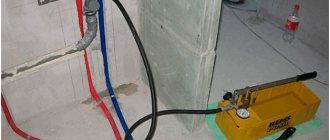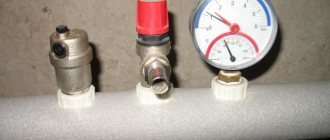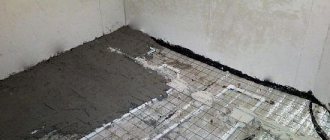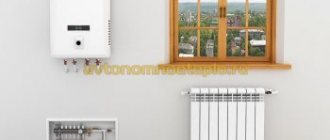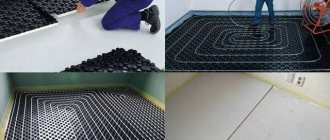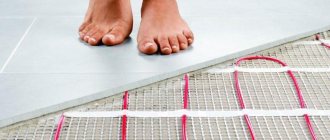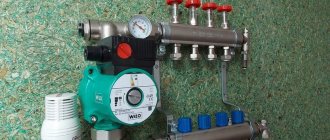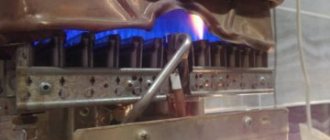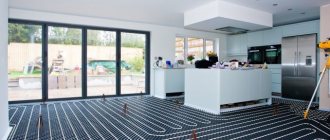Warm water floors are gaining popularity today, especially in private buildings, as they are more economical, unlike electrical devices in which the heating source is a cable. But not everyone knows how to properly turn on the system for the first time, and this is an important and responsible undertaking.
If the heated water floor is filled incorrectly, operational problems will arise, as a result of which it will be necessary to dismantle the structure, which will at least lead to additional costs.
If the floor is laid on logs or in a flat way, then after filling the pipes it can be turned on immediately. When installing a heating device using a screed, the first start-up is more difficult and time-consuming.
Why do you need to remove air?
The formation of voids reduces the efficiency of the heating system. Pumping equipment, like other components, operates less efficiently. To ensure comfortable indoor temperature conditions for users, more resources have to be spent.
As such voids increase, the pressure gradually decreases. After reaching the maximum minimum level, the corresponding signal is sent to the boiler control unit. In addition to electronic devices, mechanical means for similar purposes are used. This is an emergency situation, so the automation turns off the supply of gas or other fuel.
To turn it on again, you have to manually increase the pressure. But there are a lot of gaseous inclusions in fresh water, so negative processes are accelerated. The equipment will turn off more often.
It should be remembered that oxidation, which destroys metals, occurs in the presence of water and oxygen. Adding a new coolant activates the corresponding negative processes. In this operating mode, the durability of heating equipment is reduced.
It is necessary to exclude the appearance of air “plugs” in the heat exchange units of boilers. These parts are exposed to very high temperatures.
The reasons listed above are enough to understand the need for preventive measures. Carrying them out will prevent complex breakdowns and costs associated with restoration work.
Technical subtleties and nuances
In preparation for draining, it is necessary to study the structure of the collector in order to find and mark on the supply and return the location of the valves, marked as follows:
- servers are red;
- reverse flow - blue.
Connection diagram for a compressor for emptying the circuits of a heated floor system.
If you confuse the supply with the return, the drain system will not work - the check valve will block the pipeline.
If there is no receiving container, then you can connect the drain hose to the return valve and stretch it to the nearest sewerage intake - a toilet, sink or drain.
Collector unit for a warm water floor system
Having finished draining water from one circuit, empty all the others in the same way. When draining a section of the system, the valves of the remaining circuits must be closed, and at the end of each stage, the taps of the emptied pipelines must also be closed.
To completely empty the circuits, the purge procedure can be repeated after an hour - when the moisture from the walls of the heat pipes has drained and accumulated in some area.
Draining water in stages
Warm floors are a closed system, so you should take care of the drain taps during installation work. The number of valves must be equal to the number of water circuits.
- This is basically a long hose that is laid on the floor. Laying option, i.e. the configuration of the circuits may be different, but the liquid circuit operates on the same principle - the coolant transfers heat to the surrounding space by heating the floor surface.
Before draining, the heating system must be turned off, then wait the time required for all its elements to cool completely.
Taking into account that the water circuit is connected to the main pipeline, and the connection point is located above the floor level, the water is drained forcibly using an air compressor.
The power of a household vacuum cleaner to drain liquid from a water heating system is not enough.
Emptying is carried out through a return line equipped with a drain valve, and the compressor is connected to the manifold on the inlet pipe; because of this, the check valve can create certain interference when purging the pipe.
After connecting to the collector, the compressor starts to displace the coolant from the circuit and the air supply pressure is slowly increased - until the point after which liquid begins to flow out at the outlet. Do not forget that the volume of water in each of the heated floor circuits is not that large, so an ordinary small container of 8-10 liters is enough to receive it.
The compressor must be turned on until air begins to flow continuously from the pipe immediately behind the water.
When you do not have the opportunity to use a compressor, you can use another method to empty the system of liquid and thereby avoid defrosting the heating system. A suitable size hose 1 meter long with a funnel at the end is put on the inlet of the heat pipe. The end with the funnel needs to be raised higher and antifreeze slowly poured into it (it’s better to take a brightly colored one). Gradually, water will begin to flow from the return pipe, and then liquid. The procedure will take time, but you will not regret the effort.
Test run
Pressure testing is a pressure test of the entire system for the possible presence of leaks in the pipes and at their connections.
Without this step, pouring the solution and laying the final coating is simply stupid. It is carried out when all pipes are connected to the distribution manifold.
Each heating circuit must be individually filled with liquid until all the air is removed from it. To do this, valves, both control and thermostat, must be opened and closed.
Each type of underfloor heating pipe requires its own type of crimping:
- If metal-plastic is used, then for start-up use cool water supplied to the system under a pressure of 6 bar. If it does not fall off within 24 hours, then the structure has passed the test and you can begin the upcoming work - pouring the screed over the water-filled pipes that are under pressure. During the entire test step at this pressure, the air vents must be closed, otherwise water will flow through them.
- For cross-linked cellophane pipes, the check requires different actions:
- firstly, the pressure for crimping should be twice the working pressure, but not lower than 6 Bar;
- secondly, you need to watch when it starts to fall (about 30 minutes) and raise it again;
- thirdly, such actions should be carried out three times and only after which it is necessary to double the pressure again and leave the system for a day;
If during this period of time the pressure has dropped to less than 1.5 Bar and no leakage is visible, then the system has passed the test.
As an additional check, experienced craftsmen advise using a test with the highest heating of the system. The first heating of a water heated floor will show how high-quality the pipes are. To do this, you need to heat them to 80-85 degrees and leave them for half an hour. If no leaks or steam are visible anywhere, then the structure is ready to be filled with the substance.
After all checks, the screed must be poured only onto full pipes so that it “takes into account” their modified shape.
Why do you need to drain the water and when is the best time to do it?
Water from the boiler must be drained in the following cases:
- If the water heater is located in an unheated area, the tank must be emptied before winter arrives. With the onset of frost, the liquid will begin to turn into ice and increase in volume, which can lead to serious damage to the device and loss of its functionality.
- If the warranty period for the boiler has expired, and the structure needs to be repaired or the magnesium anode replaced, the water must also be drained. All such procedures are carried out only with a dry and clean tank. It is worth noting that during the warranty period you cannot carry out repairs yourself, otherwise the warranty will become invalid.
- At least once every 5 years, the water heater must be descaled. If the water supplied to the tank is not of good quality, it is advisable to carry out a similar procedure more often. The sediment that remains in the tank interferes with the rapid heating of water, which means that the boiler consumes more electricity to operate.
Now I would like to consider cases when there is no need to drain water from the boiler:
- When turning off the water heater during the warm season, it is not recommended to drain all the liquid from the tank. If the device is not threatened by frost, it is better to leave some water in the container - this will protect the interior of the tank from corrosion. In addition, if, out of forgetfulness, you plug in an empty boiler, a fire hazard may arise.
- If the device has been left unplugged for some time and the water in it has stagnated, it is also not worthwhile to completely empty the container. Stale water simply needs to be refreshed by filling the tank full several times. It is advisable to repeat this procedure every 3 months, running 100 liters of cold water through the heater.
- If the unit is still covered by the warranty, it is highly not recommended to drain the water, much less repair any parts yourself. In such a case, the warranty will become void. If problems arise with the boiler, it is better to simply call qualified specialists. They will drain the water themselves, fix the breakdowns and do it for free.
You can use a suitable container to drain water from the boiler.
Why drain the water?
There are many reasons why you may need to drain your underfloor heating system. For example, this procedure should be carried out if the owners are away from home for a long time, or when there is a need to replace water as a coolant with antifreeze. Everything must be done correctly so as not to violate the integrity of the system. Below we will consider the rules for draining liquid.
Often this need arises when preserving the heating system for the winter. This procedure is often carried out in summer cottages and in houses outside the city that have been empty for a long time. To simplify and speed up the draining process, a special technique is used.
Remember that water in houses with seasonal use must be drained. Otherwise, frost will cause the system to freeze. That is why the use of antifreeze as a coolant is more preferable - in addition to resistance to low temperatures, this solution also protects pumps from excessive wear.
Another, also important point when using heated floors is preventive maintenance in the heating system. The water from the boiler contains many impurities, which, when heated, precipitate or form deposits on the walls of the pipeline.
Due to a decrease in the internal clearance of heat pipes, the circulation of the coolant in the system is disrupted, and the heat output becomes lower. Therefore, experts recommend draining the coolant from the system at least once a year when using water.
A liquid circuit that is filled does not have this problem. In this case, the coolant can be replaced only once every 3-5 years (the main condition is that the boiler operates without overheating; for heated floors, the maximum threshold for permissible liquid temperature is 45-55 °C).
Another reason why it may be necessary to drain the water is the loss of the liquid’s own physical properties. The antifreeze parameters change after overheating - the solution begins to form foam. When foam fills individual sections of heat pipes, it disrupts the circulation of the coolant in the system and heat transfer becomes lower.
Inconsistency in the installation technology of heated floors and the use of materials that are not intended for contact with chemicals contribute to the formation of corrosion in the heating system. As a result, the circulation of the coolant is disrupted and leaks in the water circuit appear.
Of course, you will have to drain the water from the heated floor circuit when replacing it with antifreeze.
These are the main reasons when systems need to be drained
And no matter what the base, water drainage must be carried out in accordance with all the rules, following safety precautions and the technological sequence of all points
Rules for using antifreeze
The use of ready-made high-quality coolants allows you to increase the efficiency of heated floors. Regardless of the type of antifreeze for the heating system, during the operation of the solution, the following basic requirements should be adhered to:
- For metal pipes of heated floors, antifreeze is used, which contains additional anti-corrosion additives.
- Due to the high level of viscosity of the finished coolants, the installation of circulating pumps with high power is required. In this case, the pipeline must have a diameter of more than 20 millimeters.
- It is necessary to replace antifreeze on time. The period of use of the solution depends on its type. For reagents based on propylene glycol and ethylene glycol, the service life is about five years. Glycerin antifreezes have a longer service life - up to ten seasons.
- Before using ready-made coolants, check the tightness of all connections. This point is of particular importance when using ethylene glycol, since its contact with the finishing coating leads to the destruction of the material, and human inhalation of vapors can cause serious poisoning.
- Antifreeze should be used for the floor heating system after the water circuits have been completely flushed. Metal pipes should not have rust or various deposits in the form of scale inside.
Antifreeze for underfloor heating is the best way to protect the system in winter. Its use allows you to easily turn off heating equipment for a long time on the coldest days.
The effectiveness of using ready-made coolants depends on the correct selection of the composition and its compliance with the technical requirements for installing heated floors. When purchasing such a liquid, you should always pay attention to the compatibility of the product with various materials, and also take into account the characteristics of the additives included in the composition.
Consequences of air jams
Possible consequences depend on the installation object, as well as the design features of the heating system.
- Warm floors from a centralized heat supply source: partial or complete cessation of heating, possible freezing of pipelines in corner rooms;
- Houses with heated floors and heating appliances from a centralized heat supply source: partial or complete cessation of floor heating;
- Warm floors from an individual heating source: partial or complete cessation of heating, possible emergency stop of the boiler and freezing of the heating system;
- Houses with heated floors and heating appliances from an individual heating source: partial or complete cessation of floor heating, frequent boiler shutdowns.
Considering the specific design of the “warm floor” heating system, namely: the presence, depending on the area, of one or several water circuits per room and separate wiring for each room, complete cessation of circulation is almost impossible.
Only if air jams occur on all horizontal branches in all rooms at once will the movement of the coolant and the functioning of the system stop.
What to fill?
There is no clear answer to this question: it all depends on the specific conditions in which the country house and its owner are located. But if you want to come to your cottage in winter and immediately turn on the batteries, then fill the system with antifreeze - you won’t go wrong! Properly selected elements of the heating system, their precisely calculated parameters and characteristics, the correctly selected type of antifreeze and high-quality installation of all components are the guarantee that the heating system will serve reliably and for a long time.
Materials, equipment and procedure for draining water
To perform the necessary work, you will need a compressor, and of good performance, with a receiver for storing compressed air.
As you already understood, a car one is not suitable for these purposes.
If you are planning to drain used antifreeze, then you yourself understand that it is not worth draining it anywhere.
Clamps of the appropriate size for a reliable hose connection will also be needed.
Connect the hose from the compressor to the underfloor heating supply manifold.
The supply manifold may or may not have a special fitting in its design for filling the system under the hose. Therefore, the automatic air vent is unscrewed on the supply comb and a hose is connected through a suitable adapter and tightened with a clamp.
Arrangement of elements on the manifold for draining
- In the same way, connect the hose to the return manifold and lead it to the drainage point.
- Close the supply and return valves coming from the boiler in the manifold area.
- Using flow meters or valves (depending on your collector), close all underfloor heating circuits, except one, which, on the contrary, needs to be opened to the maximum.
- Turn on the compressor, open the valves or tap (depending on the type of comb) that are designed to fill and drain the system (those with hoses on them). At this moment, the coolant will begin to flow out of the drain hose under pressure. Wait until the water runs out and air comes out. At this point, pay attention to the pressure gauge on the compressor. If the pressure in the receiver at this moment is not high (1-3 atm), then close one of the taps on which the hose is attached (preferably, it would be a tap on the supply manifold, or if the pump is equipped with its own shut-off device, it is better to use it) . Wait for the pressure to rise to 5 atm. (no more) and blow out the floor loop under this pressure.
- Close the blown circuit and open the next one. Repeat the same procedure with him.
- In this way, drain the water from all underfloor heating circuits.
- For better efficiency, repeat the procedure after half an hour, since the remaining droplets of water in the pipe can connect with each other and eventually block the cross-section of the pipe in a certain place.
By following this method, you will solve the problem of how to drain water from a heated floor. The only problem is getting a compressor that can handle this task.
Self-pressure testing of underfloor heating systems
First launch of a warm water floor
Rules for installing a heated water floor based on a concrete screed
How to flush a heated floor heating system and how to completely flush the heating system in a private house with your own hands
Installation of water heated floors without concrete screed
Warm water floor system technology
Crimping technologies
In order not to dismantle the water heated floor, you can create high pressure conditions before starting. Testing is also performed after assembly to determine leaks, ruptures, and areas of corrosion. The procedure consists of pressure testing and flushing of the line, checking and replacing components, and restoring the insulating coating. Depending on the state of communications, you can select the appropriate technology.
Using water
Before pressing the heated floor, install a collector box and connect the water circuits for heating. The system is filled with water from the supply tap - the caps are screwed on the return manifold, and in supply mode the tap is brought to the open position. The liquid enters the line, displacing air through the diverter, as evidenced by hissing.
To bleed air masses, the return valve of one or more circuits is opened. The steps must be repeated until the air is pumped out of the pipes. Once bleeding is complete, the collector inlet valve closes.
The hydraulic method is also divided into several types.
The control check is carried out with a gradual increase in operating temperature. Initially, water is supplied to the circuit at +20 degrees, after a few hours the temperature increases by 5 degrees. After this, joints, external sections of the pipeline, and attachment points are checked.
If there are leaks, water is drained from the system and the faults are repaired. After re-supplying the coolant and reaching the desired temperature, the system is not operated for 2 days. Breakdowns are determined visually, the temperature is lowered to a cool state, then the screed is poured.
High pressure is created by filling the line with cold water. Pressure parameters should exceed the norm by 1.5-2 times. The valves are closed and the circuit is not operated for 24 hours.
During this time, water flows out from ruptured pipes or connections. Damaged areas are determined visually. Repairs begin after removing the coolant. Upon completion of work, re-inspection is carried out and the system is filled.
The optimal pressure indicator is from 2.3 to 2.8 atm.
Air crimping
The procedure for pressure testing a heated floor system using air is performed when it is not possible to test them with water. To create excess pressure, use a floor compressor, a car pump or a sprayer with a pressure gauge. The air pressing technology is implemented as follows:
- Checking the condition of the taps. They close hermetically.
- Removing the automatic air vent and installing a temporary plug in its place.
- Connecting a device that pumps pressure. A hose is attached through the fitting, and then a tap.
If the system operates under a pressure of 1.5 to 2 atm, it is necessary to test at a pressure of 4 to 5 atm.
Formation of air masses in a heated floor system
A pump is needed to bleed the system.
How to bleed air accumulated in the system will depend on the incident that led to such a result.
Some circumstances require immediate intervention, while others are not capable of causing significant damage to the system.
If the heated floor was installed with noticeable differences, it is worth acquiring an additional pump for pumping the coolant.
Running the circulation pump will also help expel excess air. The more air has accumulated, the louder the circulation pump will work.
It is worth paying attention that the system must be pumped at maximum speeds. This will significantly save time and allow you to completely remove air from the system.
If it was recently pumped, but the air has already collected again, the problem may be in the pump itself.
Air vent
With the comb installed, each circuit is closed in turn, and the air vent must be open on each of them. It is necessary to bleed air gradually, so after cleaning the first circuit, the next one opens. The descent is carried out in stages and at the moment of bleeding only one circuit should be open.
If this procedure does not give the expected result, the next air release should be carried out no earlier than in a few days.
To properly clean the system, a person must understand the structure of the comb and understand the principle of its operation. If you do not have the necessary knowledge, you should seek help from specialists. watch the release of air in this video:
Emergency situation
By emergency we mean a case where the battery leaks. Again, if there is a tap that turns off the battery, turn it off and drain it; if not, you cannot do without calling a plumber.
The battery does not heat up
Cold water in the radiator, although the heating has been turned on a long time ago? Means, . In theory, your radiators should be equipped with a Mayevsky tap. If your battery is installed correctly (the angle in which the valve is installed should be slightly higher), then when you open the valve to bleed off excess air, only air will come out; as soon as the water starts flowing (don’t forget to immediately replace the jar), it means that the air has escaped and there is no more plug. If the radiator is installed completely horizontally, you may have to drain more water.
The rifar radiator has special drain taps
The Mayevsky crane is not installed? Perhaps it is better in this case to turn to specialists. Why?
Equipment tends to break down over time. Imagine that you managed to cope with coking and drain the water. But closing them is no longer possible.
Can you imagine what consequences this will lead to?
- Firstly, you will flood your neighbors, and you will still have to call a locksmith to turn off the heating in the entire house.
- Secondly, you will leave the entire house (or at least the entrance) without heating for quite a long time - until the consequences of your “amateur activity” are eliminated.
- In addition, if heating in your home is provided by an individual boiler, then the contract you concluded with the service organization states that it is prohibited to drain the water yourself. This is due to the loss of the required pressure level, which is signaled by special emergency sensors.
How to start a warm water floor correctly
The first launch of a warm water floor is carried out by heating the coolant to +20-25 degrees. You need to let the system settle for a couple of days, after which every day increase this indicator by 10 degrees if water is used and by 5 if the coolant is antifreeze.
The entire process of gradual heating of the structure directly depends on the size of the room. If it is small, then you can do it in just a couple of days, but since the launch of a warm water floor is arranged after all the checks, pouring concrete and laying the floor covering, it is better not to rush with a sharp rise in temperature. This may cause cracks to appear in the screed.
What will be the basis?
In houses where the floors are made of concrete, as well as on the base (provided the base of the floor is located on a sand cushion), the common method of concrete screed is used. Important! If your house has wooden floors, this method is unacceptable for you. The beams simply will not withstand the load, no matter how thin the layer of concrete screed is. In such situations, a lightweight option is used, its description can be found below.
The first step when installing a heated floor is to prepare the base. The base must be flat; the presence of depressions or protrusions is unacceptable. The difference can be a maximum of 5 mm. If there are defects or stronger differences, you should:
- Fill with fine crushed stone in a thin layer (grain up to 5 mm) and level it.
- Cover the finished leveling layer with film.
- When laying heated floors, use wooden boards to walk on them, otherwise the crushed stone layer itself will create unevenness.
How to drain water from a heating system
When is it necessary to drain water from the heating system? Most often, the need for it arises when it is necessary to clean or replace a heating radiator, for example. If we are talking about a city apartment that is connected to a central heating system, then such an operation can be carried out independently on the internal section of the network. In the event that it is necessary to drain the heating system of a private house equipped with a boiler, it will have to be temporarily emptied.
The essence of the
The first step is to shut off the branch of the heating riser that goes to the apartment. It is enough just to close the distribution valve located here. For a private house with an autonomous heating system, this process is slightly different:
- firstly, you need to stop the supply of fuel or electrical energy;
- secondly, you should carefully read the user instructions for this case.
Only after this can the boiler be turned off. Then you should close the valve through which water is drawn into the system.
Only after this can the boiler be turned off. Then you should close the valve through which water is drawn into the system.
To speed up the process a little, you will need to know those places in the system where taps with air-type valves may be located. They all need to be opened. In this case, nothing will interfere with the flow of water to the hose.
During this operation, small leaks of water from the system onto the floor are possible. Therefore, at the very beginning, it is better to place a large bowl or basin under the place where the hose is connected to the tap (drain). As all the water leaves the system, it is necessary to disconnect the hose and drain the remaining water from it into a substitute container.
Only after completing all the described procedures can you move on to the main thing - to the work for which the water was drained from the heating system of a residential apartment or private housing construction.
If the owner of an apartment or house does not quite understand how to drain the water from the heating without harmful consequences, then it is better to contact a qualified contractor. For example, to a plumber from a company that services a specific home.
termosyst.ru
Selecting an antifreeze fluid
For filling into heating systems of private houses, the market offers 2 types of non-freezing coolants made on the basis of:
- ethylene glycol;
- propylene glycol.
The first type of antifreeze can be described in literally two words - cheap and toxic, while propylene glycol is safe but expensive. For obvious reasons, most sellers actively offer the second type of coolant, focusing on its safety for human health. At the same time, a theory is being developed that a small amount of coolant can get into drinking water through the hot water supply system or poison almost every living thing in the house if it leaks from the connections of the heating system.
In fact, high-quality and correctly installed heating will not give the slightest chance for antifreeze to get into the water, and leaks are so insignificant that they do not pose a danger. Another thing is the loss of the warranty on the boiler, because most manufacturers do not allow their heat generators to operate with anti-freeze. But this applies to any glycols, except those that the boiler manufacturer itself allows for use.
The conclusion is simple: when you are confident in the quality of the assembly of your heating system and are short on funds, then feel free to fill in ethylene glycol, carefully monitoring the process and strictly following the instructions. If you want to be on the safe side, backed by opportunities, then pay the required price for propylene glycol, fill it up and sleep peacefully.
In most cases, antifreeze for heating systems is sold in the form of a concentrate, which must be diluted before being poured into the heating network. It is recommended to dilute it strictly in accordance with the instructions; there is no need to make the solution too strong. This can cause deposits to appear in different places and on the heat exchanger. Antifreeze must be changed no later than after 5 years of operation.
We expel the air
It is a well-known fact that air in heating systems accumulates at the highest points of the system. For underfloor heating systems, this is a collector comb, where air discharge devices are installed (Mayevsky valves, automatic air vents or conventional ball valves).
Mayevsky tap installed on the underfloor heating manifold.
To remove air from the underfloor heating system, you must perform the following steps in a certain sequence:
- Shut off all horizontal branches on the collector.
- Remove air from the circulation pump housing.
- Open the Mayevsky valve or ball valve on the comb (in the absence of automatic devices).
- Open the first water circuit, start the pump, setting the minimum capacity on the regulator.
- After waiting for water to appear from the air outlet of the pumped branch, turn off the tap and turn off the pump.
- Repeat the operation several times at intervals of 5 - 6 minutes until the air is completely removed.
- Similarly, perform all operations with the remaining contours.
- Then, switching the pump to maximum performance, pump the entire system as a whole, periodically bleeding air.
- Considering the likelihood of new plugs forming during subsequent warming up of the system, it is necessary to bleed the air again.
Important! Putting the system into operation is possible only after all these measures have been taken and it has been fully checked for leaks. To work with Mayevsky taps, you must have a special key or slotted screwdriver
It would be useful to prepare a special container for drained water.
When using automatic gas vents or separators as air removal equipment, no additional means are required. It must be remembered that as the complexity and quantity of equipment used increases, the cost increases and the reliability of the system as a whole decreases.
Types of fan coil units, their differences and features
The lower the degree of automation of the process, the higher the performance of heated floors. Adjustable manifold valves with a mechanical drive, Mayevsky taps are easy to service or replace with your own hands.
Repair of more complex equipment with servo drives and automation units requires the participation of specialists. In addition, automatic air vents, while effectively removing air pockets, do not always allow immediate detection of system leaks.
Coolant refilling process
Before filling the water heated floor with coolant, all valves on the collector unit are closed, and the hose is connected to the inlet tip. When it is planned to flush the system, a hose is installed at the outlet, the opposite end of which is inserted into the sewer system, drainage pit or into a special container.
Filling begins with the first loop, for which the valves on this circuit are opened, and all the others are left closed. The pipes are filled with liquid and air is released, resulting in a hissing sound in the air vent valves.
The pump is turned on for a short period, the noise of the valves is heard again, after which it is turned off. Next, wait until the air is completely released and turn on the pumping equipment again. The process is repeated until all air pockets are eliminated and the second loop begins to be filled.
Before filling the second circuit, the valves of the already filled circuit are closed. The procedure is carried out until all loops of the system are filled. Then all inlet and outlet valves on the circuits are opened, and the coolant is pumped until the air is completely removed. The system is now prepared for testing or launching water heated floors.
You are required to vacate the room in which the installation will be carried out and prepare a place for building materials. A warm water floor is a pipeline installed at the base of the floor. The design of such a heating system includes:
- Removing the floor covering (if any).
- Preparation of the base. The surface of the subfloor is cleaned of dust and debris and treated with primer.
- Marking the area of heated floors.
- Thermal and waterproofing device. Along the entire perimeter of the room, where the walls meet the floors, a damper tape is attached to the walls. Thermal insulation (foam plastic, penotex or other, at your request) with a density of at least 35 kg/m3 and a thickness of 3 to 15 mm is laid. The top of the insulation is covered with plastic film.
- Installation of a heating system. Reinforcing mesh is laid, with a cell of 150 by 150 mm and a cross-section of 4-5 mm. Metal-plastic or PVC pipes of the required diameter, at least 20 mm, are mounted on it according to a certain pattern (parallel or spiral laying method), in increments of 30 to 70 cm. Then the pipes are fixed on the mesh. Sometimes a water floor is installed without reinforcing mesh, then the pipeline is attached with clips to the film. The return and supply pipes are connected to the collector or central heating system. Shut-off valves with compressor fittings are installed.
- Checking the operation of the system and, if necessary, pressure testing the pipes.
- Installation of beacons.
- Installation of cement-sand screed.
Water heated floors have a number of advantages:
- This is an economical heating option;
- compatibility with any types of floor coverings;
- the heating system can operate autonomously;
- installation is relatively inexpensive.
Our specialists will provide detailed advice on all issues related to the operation of a water floor. Depending on the complexity of the system, the work lasts from one to three days.
Extensive experience allows our craftsmen to install pipelines on wooden floors.
After completion of the work, we guarantee cleanliness and order, and also give a guarantee (2 years) for the work performed. We install water heated floors in Yekaterinburg, Berezovsky, Aramil, Verkhnyaya Pyshma and surrounding cities at competitive prices.
